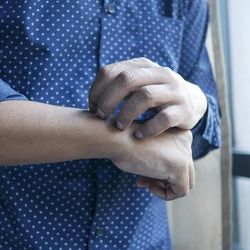
OR WAIT null SECS
ADORING Trial Open-Label Extension: Tapinarof Cream 1% Results in Atopic Dermatitis
This interview at the Fall Clinical Dermatology Conference features a discussion with Stein Gold regarding the open-label extension of the phase 3 ADORING trial regarding tapinarof.
An announcement by Dermavant Sciences highlighted new clinical data from open-label, long-term extension (LTE) study of ADORING 3 for tapinarof cream, 1% (Vtama) treatment of adults and children as young as 2 years of age with atopic dermatitis.
The new findings were presented at the 2024 Fall Clinical Congress in Las Vegas, with investigator Linda Stein Gold, MD, discussing the findings with the HCPLive editorial team in a new interview.
“This was a really exciting study,” Stein Gold explained. “This is long-term, open label, and really a safety study, but we were also looking at efficacy and the patients who completed the phase 3 clinical trial as well as a 4-week maximum use study. They were eligible to enter into this long term study.”
Stein Gold highlighted that over 80% of the 728 participants between age 2-17 years achieved clear or almost clear skin, noting that approximately 52% achieved completely clear skin at some point. Tapinarof was also shown to be well-tolerated, even on those with sensitive skin.
“One of the interesting aspects of this study was researching whether or not we could have a disease-free period of time, or a remittive effect,” she said. “We saw this in the psoriasis studies. We saw that when we got patients completely clear with tapinarof in patients with psoriasis, on average, they went for 4 months before they got mild disease or worse, back. And we saw something similar in the atopic dermatitis population as well.”
Subjects experiencing an average of 80 consecutive days of clear skin before relapsing to mild disease or worse. This suggests potential for the drug treatment-free periods and long-term management of atopic dermatitis.
There were no new safety signals over 48 weeks. The investigators noted that most of the observed treatment-emergent adverse events were shown to be mild or moderate, with the most frequent being nasopharyngitis for 6.9%, folliculitis for 12.1%, and upper respiratory tract infections for 6.9%.
“I think what's really important, especially when we're talking about children and even adults with atopic dermatitis, is their skin is so sensitive,” Stein Gold explained. “Some of them have a hard time even putting on topical moisturizer, because it can sting and burn. The good news was tha tapinarof was really well-tolerated, and it was well-tolerated over all the different body sites. I think that's really important when we think about using topical therapy in atopic dermatitis patients.”
To find out more about these new data, view the full interview segment posted above. Check out the latest conference coverage of Fall Clinical presentations and data here.
The quotes contained in this summary were edited for clarity.
Stein Gold has reported grants and personal fees from Arcutis Biotherapeutics as well as grants from Dermavant, AbbVie, and Lilly; and personal fees from Dermavant, LEO Pharma, Ortho, Pfizer.
Related Content:


